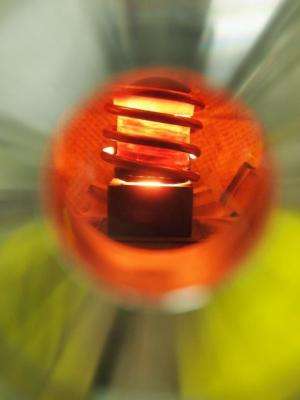Reacting to meltdown

The National Physical Laboratory (NPL) has helped CEA (Alternative Energies and Atomic Energy Commission of France) measure high temperature reference standards in one of their research furnaces, which are used in studies to help minimise the risk of nuclear accidents through better plant design and the improved understanding of stages involved in severe reactor accidents.
When a nuclear reactor experiences a 'meltdown' it produces corium - a hot liquid mixture of uranium oxide fuel, zirconium from fuel cases, and steel and concrete from the reactor structure. This corrosive liquid can eat its way through a reactor core containment vessel and, if it makes contact with reactor coolant, can cause steam explosions and produce hydrogen. This hydrogen can lead to further explosions, similar to those witnessed at the Fukushima Daiichi nuclear power plant in Japan following the earthquake and tsunami that struck it on 11 March 2011.
At its Cadarache research facility in the south of France, CEA studies corium at temperatures up to 3000 °C to help minimise risk through better plant design and improved understanding of the stages involved in severe reactor accidents.
NPL is involved in a collaborative research project called 'High temperature measurement for industrial applications' (HiTeMS), which is funded by the European Metrology Research Programme (EMRP). As part of this larger project, NPL and the National Measurement Institutes of France (LNE-Cnam) and Turkey (UME) helped CEA measure high temperature reference standards in one of their research furnaces.
The calibration of temperature measurement equipment requires the use of fixed reference points, usually based on the melting or freezing point of certain substances. In this instance NPL provided rhenium-carbon fixed points that have a reference temperature of 2474 °C. These were designed by LNE-Cnam to be very robust, and proved to be so as they coped with extreme temperature changes of up to 1000 °C per minute inside the furnace.
NPL's Dave Lowe, who worked on the project, said: "Having their own fixed points will allow CEA to calibrate their temperature measurement equipment in situ, giving them greatly reduced uncertainties and improved knowledge for designing safety systems."
More information:
More on NPL's work on Temperature Measurement.
More on EMRP Project: High temperature measurement for industrial applications (HiTeMS).
Provided by National Physical Laboratory


















